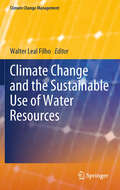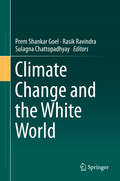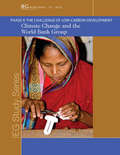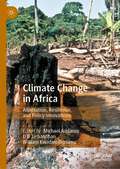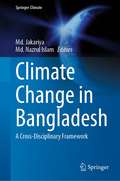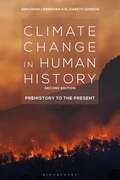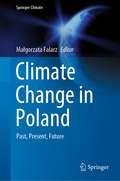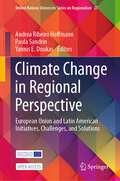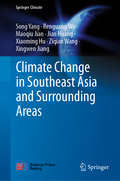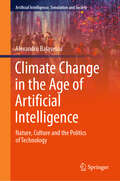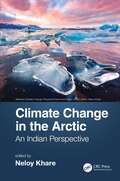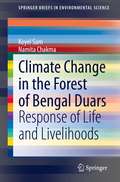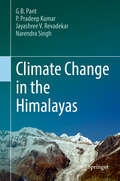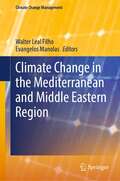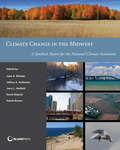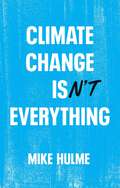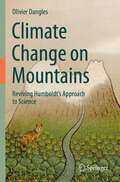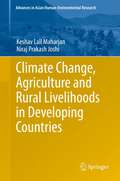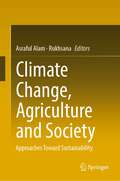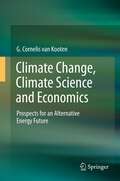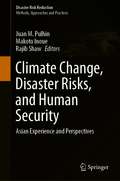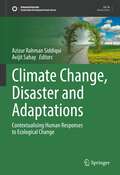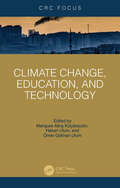- Table View
- List View
Climate Change and the Sustainable Use of Water Resources (Climate Change Management)
by Walter Leal FilhoThe book explores the geo-chemical, physical, social and economic impacts of climate change on water supplies. It contains examples and case studies from a wide range of countries, and addresses the need to promote sustainable water use across the world.
Climate Change and the White World
by Rasik Ravindra Prem Shankar Goel Sulagna ChattopadhyayThis book showcases the results of studies pertaining to climate changes in the Polar Regions - Arctic-Antarctic-Himalaya. It discusses the significant variations due to thinning of sea ice in the Arctic, insights on the first Indian Arctic multi-sensor mooring (IndARC), political context of major geological and tectonic features of Arctic Ocean, climate change and its predicted impacts on fisheries and coastal communities. The book also contains the work pursued under the National Mission for Sustaining the Himalayan Ecosystems, aiming towards strengthening the capacities of farmers through appropriate Lab-to-Land intervention to combat climate change issues. Discussions on various models like WRF (Weather Research and Forecasting), Regional Climate Model (RegCM4) pertaining to Himalaya have been highlighted to gain more insights on climate change.
Climate Change and the World Bank Group
by The World BankThis study from the Independent Evaluation Group draws lessons for development and climate change mitigation from the World Bank Group's far-reaching portfolio of projects in energy, forestry, transport, coal power, and technology transfer. Reviewing what has worked, what hasn't, and why, the evaluation's key findings include: Energy efficiency can offer countries direct economic returns that dwarf those of most other development projects, while also reducing greenhouse gas emissions. Tropical forest protected areas, on average, significantly reduce tropical deforestation, preserving carbon and biodiversity. Deforestation rates are lower in areas that allowed sustainable use by local populations than in strictly protected areas. Deforestation rates were lowest of all in indigenous forest areas. For renewable energy projects, long-duration loans have been important in making projects financially viable.. But at prevailing carbon prices, carbon offset sales had little impact on most renewable energy projects' rate of returns, and did not address investors' need for up-front capital. Technology transfer - broadly understood to include diffusion of technical and financial innovations related to low-carbon development - has worked well when the logic of piloting and demonstration is well thought out, and when grants are used to mitigate the risk of pioneering efforts.
Climate Change from the Streets: How Conflict and Collaboration Strengthen the Environmental Justice Movement
by Michael MendezAn urgent and timely story of the contentious politics of incorporating environmental justice into global climate change policy Although the science of climate change is clear, policy decisions about how to respond to its effects remain contentious. Even when such decisions claim to be guided by objective knowledge, they are made and implemented through political institutions and relationships—and all the competing interests and power struggles that this implies. Michael Méndez tells a timely story of people, place, and power in the context of climate change and inequality. He explores the perspectives and influence low‑income people of color bring to their advocacy work on climate change. In California, activist groups have galvanized behind issues such as air pollution, poverty alleviation, and green jobs to advance equitable climate solutions at the local, state, and global levels. Arguing that environmental protection and improving public health are inextricably linked, Mendez contends that we must incorporate local knowledge, culture, and history into policymaking to fully address the global complexities of climate change and the real threats facing our local communities.
Climate Change in Africa: Adaptation, Resilience, and Policy Innovations
by Michael Addaney D B Jarbandhan William Kwadwo DumenuThis edited collection chronicles the public policy responses to climate change and current and potential impacts that will affect critical and priority sectors within and across African countries now and in the coming decades. Contributions cover governance and policy responses to climate change, emphasizing continental governance and policy responses, national governance and policy responses (what selected countries in Africa are doing), and local or community policy and programmatic responses (what some selected major African communities are doing). Each chapter adopts multi-disciplinary and transdisciplinary approaches, combining insights from social and policy sciences, emphasizing existing gaps, particularly in the area of decision-making, governance and local climate action. The book offers both theoretical and practical contributions, with the aim of advancing academic discourse and thinking, policymaking and implementation of climate interventions in Africa.
Climate Change in Bangladesh: A Cross-Disciplinary Framework (Springer Climate)
by Md. Nazrul Islam Md. JakariyaThis book is a comprehensive resource for climate change impacts and scenarios on cross-cutting issues in Bangladesh and other tropical low-lying countries in Asia. The book promotes mitigation and adaptation strategies for learning and innovation to tackle climate change impacts, reduce inequality, as well as include changes in food, energy, health, education, and social protection policies in Bangladesh and Asian low-lying countries.Through several case studies, this book provides a powerful framework for identifying management tools and their applications in environment and governance including; climate change and natural hazards, climate change and energy framework, gender inequality and capacity building, and community participants and the actions needed to protect them.The aim of this book is to provide information to scientists, practitioners, academics, and government and non-government policy-makers to help them better understand the particularities of climate change adaptation and mitigation strategies for cross-cutting issues in Bangladesh.
Climate Change in Human History: Prehistory To The Present
by Benjamin Lieberman and Elizabeth GordonClimate Change and Human History provides a concise introduction to the relationship between human beings and climate change throughout history. Starting hundreds of thousands of years ago and going up to the present day, this book illustrates how natural climate variability affected early human societies and how human activity is now leading to drastic changes to our climate. Taking a chronological approach the authors explain how climate change created opportunities and challenges for human societies in each major time period, covering themes such as phases of climate and history, climate shocks, the rise and fall of civilizations, industrialization, accelerating climate change and our future outlook. This 2nd edition includes a new chapter on the explosion of social movements, protest groups and key individuals since 2017 and the implications this has had on the history of climate change, an improved introduction to the Anthropocene and extra content on the basic dynamics of the climate system alongside updated historiography. With more case studies, images and individuals throughout the text, the second edition also includes a glossary of terms and further reading to aid students in understanding this interdisciplinary subject. An ideal companion for all students of environmental history, Climate Change and Human History clearly demonstrates the critical role of climate in shaping human history and of the experience of humans in both adapting to and shaping climate change.
Climate Change in Poland: Past, Present, Future (Springer Climate)
by Małgorzata FalarzThis edited book provides a comprehensive overview of the past, present and future climate development in Poland. The book consists of three main parts. The first part presents the results of the study of climate change before instrumental measurements in Poland in the last millennium. The second part analyses the long-term changes and variability of 36 climate characteristics for 14 climate elements, indices, meteorological phenomena and weather types using data from 79 weather stations in the base period 1951–2018 and for long series up to 239 years (1780–2018). The particular attention is paid to climate extremes. The third part of the book deals with projected changes in temperature, precipitation and thermal indices related to the agriculture and energy sectors. Two future time horizons are carried out: 1) near future: 2021–2050 and 2) far future: 2071–2100. The results for Poland are compared to those from Europe and other parts of the world.The book is addressed to scientists (climatologists, geographers, etc.), academic teachers, students, journalists and all those interested in Poland and climate change in Poland.
Climate Change in Regional Perspective: European Union and Latin American Initiatives, Challenges, and Solutions (United Nations University Series on Regionalism #27)
by Andrea Ribeiro Hoffmann Paula Sandrin Yannis E. DoukasThis Open Access book addresses climate change in Europe and Latin America from a comparative regionalism studies (CRS) perspective. Written by an international team of scholars and experts, chapters critically analyze proposals for mitigating climate change while contributing to the mutual understanding about the issues at stake across regions. The book is divided into three main sections. In the first section, authors discuss EU and Latin American cooperation, negotiations, and perspectives on climate change, exploring their agendas, the interests and key challenges at the global, regional and interregional levels. The second section focuses on the challenges to finance development and a greener economy. The third section explores new green solutions to climate change in the agriculture sector and initiatives such as nature-based solutions to climate change and best practices. Providing policy oriented solutions for combatting regional climate change at a critical juncture, this volume will be of interest to researchers and students of international relations, international law, and environmental politics, as well as public officials and climate change activists.
Climate Change in Southeast Asia and Surrounding Areas (Springer Climate)
by Xiaoming Hu Jian Huang Song Yang Renguang Wu Maoqiu Jian Ziqian Wang Xingwen JiangThis book is mainly focused on the climate change in Southeast Asia and its adjacent regions. It summarizes results from recent scientific research based on observational analysis, data diagnosis, theoretical analysis, and model simulations. The book covers the following research areas: (1) characteristics and mechanisms of spring–summer atmospheric circulation systems, (2) ocean-atmosphere-land interaction and climate variability, (3) climate effect of the Tibetan Plateau, (4) attribution of regional climate change and feedback/impact of regional climate on the global climate, and (5) seasonal-to-subseasonal climate prediction. It is anticipated that the book provides useful information for enhancing our understanding of the change in climate over Southeast Asia and the adjacent regions.
Climate Change in Sustainable Water Resources Management (Springer Water)
by Omid Bozorg-HaddadThis book provides a comprehensive approach to all aspects of water-related subjects affected by climate change that expand readers' attitudes toward future of the management strategies and improve management plans. It summarizes climate change scenarios, models, downscaling methods, and how to select the appropriate method. It also introduces practical steps in assessing climate change impacts on water issues through introducing hydrological models and climate change data applications in hydrologic analysis. The book caters to specialist readers who are interested in analyzing climate change effects on water resources, and related issues can gain a profound understanding of the practical concepts and step-by-step analysis, which is enriched with real case studies all around the world. Moreover, readers will be familiar with potential mitigation and adaptation measures in sustainable water engineering, considering the results of hydrologic modeling.
Climate Change in the Age of Artificial Intelligence: Nature, Culture and the Politics of Technology (Artificial Intelligence, Simulation and Society)
by Alexandru BalasescuThis book invites the reader to follow seemingly unrelated paths towards the same goal: making sense of what it means to be human in a world that casually blends discourses on nature, technology, and biology with ideas of progress, optimization and their capitalization at the centre. The author critically analyses current thinking which often looks at technological solutions to the challenges posed by climate change, and where artificial intelligence is instrumental in fulfilling the promise of ecological capitalism. He instead advocates that we take a closer look at the politics of optimization within and outside managerial perspectives, which could reveal that one of the main sources of our repeated failures related to governance and climate change lies not intrinsically in the qualities of the tools we use, but in the underlying assumptions with which we design, and in the scope of their use. Therefore, the book looks at possible solutions for humanity that may lie between the rock of technology and the hard place of nature. That is, it asks for a revision in our implicit assumptions for building our tools; critiques the thinking about our relationships with them; and re-assesses their use. Richly documented, imaginatively argued, and captivatingly written, this book explores unexpected entanglements of nature, culture, and technology that emerge in A.I.&’s unruly and unforeseen trajectories. - George Paul Meiu, Professor of Anthropology, University of Basel Balasescu develops wide-ranging thick-descriptions that provocatively draw together lotus flowers and data banks, snakes and algorithms to delve into how bodies, cultures and power are invisibly ensconced in every aspect of the digital realm. - Susan Ossman, Distinguished Professor of Anthropology, University of California Riverside This important work traces the evolution and development of the paradigms that made artificial intelligence possible and perhaps even inevitable. - Guy Nasmyth,<spa
Climate Change in the Arctic: An Indian Perspective
by Neloy KhareThe Arctic, in the polar region, the northernmost part of Earth, is the hotspot for climate change assessments and the sensitive barometer of global climate variability. This book includes the scientific observations in the Arctic region’s climate and the results obtained by scientists at the Indian Arctic station Himadri over the past decade. Designed and structured to incorporate multi-dimensional climate change research output, it is a significant contribution toward understanding, among other issues, the role of persistent organic pollutants and mercury, as well as the increase of carbon monoxide during ozone reduction in the Arctic. Features include: Highlights the achievements of climate change research in the Arctic region Includes case studies of scientists in the Arctic and their significant achievements through the Indian research base Himadri Provides a thorough review of palaeoclimate change studies, the impact of climate change on biotic components and the impact of climate change on abiotic components Provides specific details on the study of ozone depletion phenomenon over the Arctic region Covers a wide range of research contributions Details sea ice variability in the context of global warming over the Arctic region Connects seismogenesis with the climate change in the Arctic region This book will be an important read for researchers, students and all interested professionals.
Climate Change in the Forest of Bengal Duars: Response of Life and Livelihoods (SpringerBriefs in Environmental Science)
by Koyel Sam Namita ChakmaThis book focuses on more than 100 years of climatic oscillation in Bengal Duars, a unique foothill landscape of the Eastern Himalaya, to discuss the dynamics of life and livelihoods of forest dependent communities towards climate change related impacts. The authors describe the struggles the people of this region face, including climate vulnerability, displacement, migration, and human-animal conflict, and provides a unique and comprehensive analysis of the interconnection between perceptions and responses of forest villagers for survival and adaptation to climate change. The book presents advanced quantitative methods and field-based studies applied in the region to help researchers and policy makers comprehend and measure potential and actual adaptation attitudes of the villagers, while also understanding the present challenges, risk patterns, and potential impacts climate change has on the natural environment and community life. The book will additionally be of interest to students and researchers in geography, forestry, ecology and environmental science.
Climate Change in the Himalayas
by G. B. Pant P. Pradeep Kumar Jayashree V. Revadekar Narendra SinghThis book analyzes the issues associated with climate change in the Himalayas. The purpose of choosing the Himalayas as a focus is because it is a particularly fragile mountain system, highly sensitive to climate change impacts, and it contains one of the largest human populations affected by climate change. The book provides extensive data and information regarding the climate history of the Himalayas, and the current effects of climate change on Himalayan weather systems, and on human and animal populations in the region. The book begins with an overview of global climate change with discussions of data trends and international initiatives, then segues into a history of climate changes and weather trends in the Himalayas. Weather systems of the Himalayas, both past and current, are analyzed and detailed through climate models, seasonal observations of weather fronts, and overviews of various climate scenarios. The book then discusses climate change impacts and signat ures specific to the Central Himalayan region, where the largest effects of impacts are observed. Readers will discover analysis presented on water resources, meteorological changes, biodiversity, agriculture and human health along with perspectives of management and policy. This book will appeal to researchers studying climate science, climatology, environmental scientists and policymakers.
Climate Change in the Mediterranean and Middle Eastern Region (Climate Change Management)
by Walter Leal Filho Evangelos ManolasThis book serves the purpose of showcasing some of the works in respect of applied research, field projects, and best practice to foster climate change adaptation across the region.Climate change is having a much greater impact in the Mediterranean than the global average. In the Paris Climate Agreement, the UN member states pledged to stop global warming at well below two degrees, if possible at 1.5 degrees. This mark, which is expected elsewhere only for 2030 to 2050, has already been reached in the region. The situation could worsen in the coming years if the global community does not limit its emissions.The above state of affairs illustrates the need for a better and more holistic understanding of how climate change affects countries in the Mediterranean region on the one hand, but also on the many problems it faces on the other, which prevent adaptation efforts. There is also a perceived need to showcase successful examples of how to duly address and manage the many social, economic, and political problems posed by climate change in the region, in order to replicate and even upscale the successful approaches used.It is against this background that the book "Climate Change in the Mediterranean and Middle Eastern Region" has been produced. It contains papers prepared by scholars, practitioners, and members of governmental agencies, undertaking research and/or executing climate change projects, and working across the region.
Climate Change in the Midwest: A Synthesis Report for the National Climate Assessment (NCA Regional Input Reports)
by Daniel Brown Jerry L. Hatfield Julie A. Winkler Jeffrey A. Andresen BidwellDeveloped to inform the 2013 National Climate Assessment, and a landmark study in terms of its breadth and depth of coverage and conducted under the auspices of the U.S. Global Change Research Program, Climate Change in the Midwest examines the known effects and relationships of climate change variables on the eight states that make up the region. This state of the art assessment comes from a broad range of experts in academia, private industry, state and local governments, NGOs, professional societies, and impacted communities. It highlights past climate trends, projected climate change and vulnerabilities, and impacts to specific sectors. Rich in science and case studies, it examines the latest climate change impacts, scenarios, vulnerabilities, and adaptive capacity and offers decision makers and stakeholders a substantial basis from which to make informed choices that will affect the well-being of the region's inhabitants in the decades to come.
Climate Change isn't Everything: Liberating Climate Politics from Alarmism
by Mike HulmeThe changing climate poses serious dangers to human and non-human life alike, though perhaps the most urgent danger is one we hear very little about: the rise of climatism. Too many social, political and ecological problems facing the world today – from the Russian invasion of Ukraine to the management of wildfires – quickly become climatized, explained with reference to ‘a change in the climate’. When complex political and ethical challenges are so narrowly framed, arresting climate change is sold as the supreme political challenge of our time and everything else becomes subservient to this one goal.In this far-sighted analysis, Mike Hulme reveals how climatism has taken hold in recent years, becoming so pervasive and embedded in public life that it is increasingly hard to resist it without being written off as a climate denier. He confronts this dangerously myopic view that reduces the condition of the world to the fate of global temperature or the atmospheric concentration of carbon dioxide to the detriment of tackling serious issues as varied as poverty, liberty, biodiversity loss, inequality and international diplomacy. We must not live as though climate alone determines our present and our future.
Climate Change on Mountains: Reviving Humboldt’s Approach to Science
by Olivier DanglesThe world is warming up rapidly and this change is most noticeable in mountains with already observable consequences on flora and fauna. This book presents concepts, methodologies and major achievements of recent research in climate change ecology in mountains by placing this research in a historical perspective, that of travelers and naturalists of the Romantic era, and first of all Alexander von Humboldt.There is now a renewed interest, both in academia and beyond, in Humboldt, his writings and his view of nature. But how can we actually make use of his writings? How can we put his philosophy into practice? How can we still learn from past scientific figures and do a better science today? In this book, the author presents how it is possible to succeed in modern science by returning to sources, by renewing the tradition of past polymaths such as Humboldt, and by having a fully humanistic approach in science. He illustrates his point based on his 15-year experience in the study of the ecological effects of climate change in the tropical Andes, showing how he has incorporated approaches from other disciplines, from different branches of science, from history and the arts to achieve a more comprehensive view of his scientific field. Alongside hard data, discoveries by past naturalists build our understanding of the world but appealing to our emotions makes us want to understand it. In the author’s view this is a productive and enjoyable way of doing science that speaks to our humanity and also increases our knowledge about nature. This academic cross-over book appeals to a broad audience of students, scientists or, supported by attractive illustrations, to anyone interested in the adventure or making of science, but not necessarily with a scientific background.
Climate Change, Agriculture and Rural Livelihoods in Developing Countries (Advances in Asian Human-Environmental Research)
by Keshav Lall Maharjan Niraj Prakash JoshiThis book is about climate change and its relation to agriculture and rural livelihoods. It starts by providing a basic understanding of climate change science followed by the relation of climate change to agriculture, the impact of which is discussed based on the particular impact of climate change on plant and animal physiology. The book further discusses the inclusion of the agriculture sector in various international climate change negotiations. It also reviews the cost and opportunities for agricultural projects through international climate change regimes, specifically the Clean Development Mechanism under the Kyoto Protocol. With this background, the book finally proceeds to an explanation of the methodologies used to assess the impact of climate change on agriculture and empirically discusses its impact on agriculture and rural livelihoods in Nepal.
Climate Change, Agriculture and Society: Approaches Toward Sustainability
by Rukhsana Asraful AlamThis book discusses emerging contexts of global warming and climate change, agricultural vulnerability and adaptation from local to global scale. Climate change, resilience in relation to agriculture and livelihoods and multi-dimensionality of various approaches are clearly taken into account by providing studies and perspectives on various methods and scales based on natural science to social science frameworks. This edited work contains chapters that are interdisciplinary, covering climate change, agriculture vulnerability, disaster impact, productivity efficiency, food security, livelihood resilience, land degradation, sustainability, in terms of plan and perform for transformation, sustainability and adaptation, including philosophy, change and economics, as well as the natural sciences. This book addresses the sustainable development goals to reduce the adverse impacts on agricultural productivity brought on by climate change and its adaptation and disaster risk reduction in developing and developed nations. Some of the assessed challenges include soil erosion, land use conversion, natural resource mismanagement, crop productivity decline and economic stagnation. This book covers important issues in the production and consumption of food in the past and present periods, agriculture, livelihood, and climate change, disaster risk management and society. All of these are under the threat of ongoing climate change and significant challenges to livelihood sustainability. The book is arranged into five broad sections: each part will cover a set of chapters dealing with a particular issue of the climate change, agriculture and society: approach toward sustainability. This book aims to attract attention of students, researchers, academician, policymakers and other inquisitive readers interested in different aspects of climate change, agriculture, livelihood and sustainability, particularly at local to global context.
Climate Change, Climate Science and Economics: Prospects for an Alternative Energy Future
by G. Cornelis van KootenThis volume enables readers to understand the complexity associated with climate change policy and the science behind it. For example, the author describes the criticism and defense of the widely known "hockey stick" temperature graph derived from combining instrumental data and proxy temperature indications using tree ring, ice core and other paleoclimatic data. Readers will also learn that global warming cannot easily be avoided by reducing CO2 and other greenhouse gas emissions in rich countries. Not only is emissions reduction extremely difficult in rich countries, but demands such as the UN mandate to improve the lives of the poorest global citizens cannot be satisfied without significantly increasing global energy use, and CO2 emissions. Therefore, the author asserts that climate engineering and adaptation are preferable to mitigation, particularly since the science is less than adequate for making firm statements about the Earth's future climate. Readers will also learn that global warming cannot easily be avoided by reducing CO2 and other greenhouse gas emissions in rich countries. Not only is emissions reduction extremely difficult in rich countries, but demands such as the UN mandate to improve the lives of the poorest global citizens cannot be satisfied without significantly increasing global energy use, and CO2 emissions. Therefore, the author asserts that climate engineering and adaptation are preferable to mitigation, particularly since the science is less than adequate for making firm statements about the Earth's future climate.
Climate Change, Disaster Risks, and Human Security: Asian Experience and Perspectives (Disaster Risk Reduction)
by Rajib Shaw Makoto Inoue Juan M. PulhinThis book explores how climate change and disaster risks threaten human security in Asia. Climate change and disaster risks have emerged as major human security challenges in the twenty-first century, and are an imminent “threat multiplier” with the potential to harm the vital core of human life and curtail people’s freedom and ability to live with dignity. Climate change and disaster risks undermine the security of individuals, communities, nations, and the world, considering the increasing trend in the frequency and magnitude of hydro-meteorological disasters and the projections on their future adverse impacts. Despite recent advances in the literature, there is still a major gap in understanding the relationship and linkages between climate change, disaster risks, and human security, particularly as gleaned from the Asian experience. Asia is the world’s most vulnerable region in terms of the quantity and magnitude of impacts from various forms of disaster. At the same time, it has developed a number of innovative responses to address those risks, offering a wealth of experience. Exploring and capitalizing on the Asian perspective, this book provides valuable resource material for students, academics, researchers, policymakers, and development practitioners working in these areas.
Climate Change, Disaster and Adaptations: Contextualising Human Responses to Ecological Change (Sustainable Development Goals Series)
by Azizur Rahman Siddiqui Avijit SahayThis volume examines how local communities respond and adapt to ecological changes and disasters resulting from climate change. The main aim of the book is to understand the range of human responses to ecological change and to contextualise the reasons for adopting any particular adaptive strategy by a community. Through the help of specific case studies presented as individual chapters, the book aims to find out whether adaptation due to environmental stress is an individual decision and, therefore, is an isolated phenomenon, or if resilience and adaptation are part of the same action paradigm of society as a whole in response to environmental change. Of particular interest are the case studies of climate change or disasters that have rendered the site unsuitable for the return of its community at present, and thus necessitated the relocation of such communities to new locations. The case studies in the book focus on regions in India, but cover different parts of the world as well, and address concepts of resilience, vulnerability, risk, adaptation, and mitigation. The book will be useful for students and researchers in the fields of geography, disaster management, environmental science, and anthropology.
Climate Change, Education, and Technology
by Ömer Gökhan Ulum Hakan Ulum Menşure Alkış KüçükaydınThe climate change crisis is the greatest challenge humanity has ever confronted. As human activities are the most significant cause for this crisis, the solution must come from within humanity. While global movements—NGOs, universities, municipal governments, etc.—are doing their part to combat the crisis, the role of education and technology cannot be emphasized enough. Education is necessary to enhance awareness, especially among the youth, generate solutions, and implement them. Technology contributes to this process by creating climate change-fighting solutions, accumulating and analysing data, and providing energy efficiency. Technology also enables the monitoring of the climate, the mitigation of its effects, and the enhancement of the environment. Therefore, climate change, education, and the use of technology should be addressed as a unit. In this volume, the authors integrate climate change, education, and technological applications.This book is comprehensive and offers readers a variety of perspectives, encouraging the generation of novel and inventive ideas. The collaboration of authors from various disciplines to address the issue brings about novel and intriguing perspectives.
